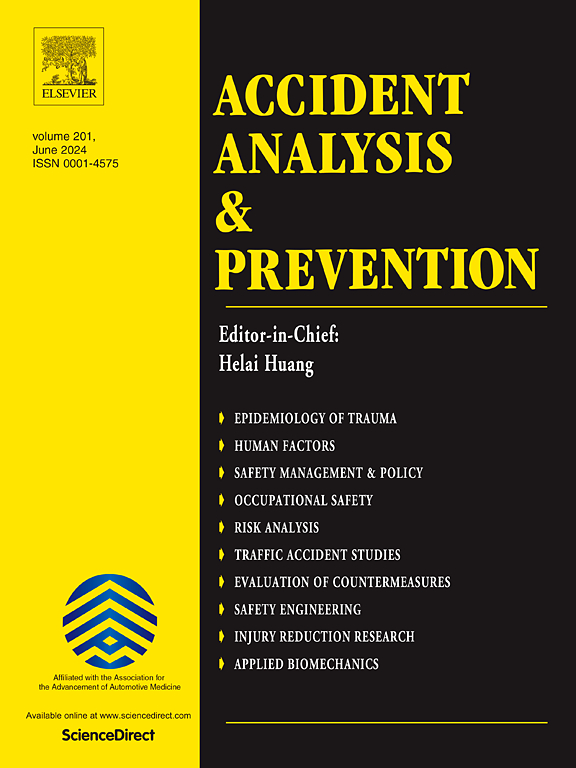高速公路隧道入口位置和相应的水平走向如何影响交通安全?从驾驶模拟实验和可靠性分析的见解
IF 6.2
1区 工程技术
Q1 ERGONOMICS
引用次数: 0
摘要
已有研究表明,高速公路隧道入口容易发生交通事故,隧道入口线形是影响交通事故发生的重要因素。然而,如何保证高速公路隧道道口线形设计的安全性,一直是人们研究的热点问题。本研究建立了一个包含五条隧道的高速公路模型,这些隧道的入口位于切线曲线段的不同位置,以全面研究入口位置对驾驶行为和交通安全的影响。通过实验得到微观驱动参数,并进一步进行可靠性分析。基于实际碰撞数据,考虑了两种失效模式:停车视线距离不足和车道偏离过大。采用蒙特卡罗采样算法计算故障概率(PoF),作为驾驶风险的有效指标。为进一步探讨影响隧道入口交通安全的各种特征,对弯道半径、螺旋长度、路面摩擦系数、行车速度4个关键指标进行敏感性分析。结果表明,隧道入口的设计位置对驾驶员的速度和车道偏离行为有显著影响。当入口位于切线上时,驾驶员速度和车道偏离行为分布最集中。相反,当入口位于圆形曲线或螺旋截面时,分布变得更加分散。失效模式和PoF与入口位置有关。基于停车视线距离不足的PoF随着入口曲率的增加而持续增加,而基于车道偏离过大的PoF随着曲率的偏离而增加。综合PoF表明,当入口位于螺旋截面的3/4处时,PoF最高,入口和出口分别达到35.66%和25.31%。曲线半径、螺旋长度、路面摩擦系数、行车速度等因素均影响隧洞洞口PoF。其中,增大曲线半径和保证足够的路面摩擦系数对减小PoF的影响最为显著。本研究对高速公路隧道入口线形设计和交通安全管理提出了建议,为道路设计者和高速公路管理者提高高速公路隧道的交通安全提供了有价值的参考。本文章由计算机程序翻译,如有差异,请以英文原文为准。
How do freeway tunnel portal locations and the corresponding horizontal alignment affect traffic safety? Insights from driving simulation experiment and reliability analysis
Previous research has indicated that freeway tunnel portals are prone to traffic accidents, with alignment at tunnel portal being a significant factor influencing crash occurrence. However, how to ensure safe design of freeway tunnel portal alignment remains unclear. This study developed a freeway model with five tunnels, whose portals are located at different positions along a tangent-curve section, to comprehensively investigate the impact of portal locations on driving behavior and traffic safety. Microscopic driving parameters were obtained through experiments and further analyzed using reliability analysis. Based on real-world crash data, two failure modes were considered: insufficient stopping sight distance and excessive lane departure. The probability of failure (PoF) was calculated using the Monte-Carlo sampling algorithm as an effective indicator of driving risk. To further explore various features affect tunnel portal traffic safety, sensitivity analysis was conducted on four key indicators, include curve radius, spiral length, pavement friction coefficient, and driving speed. The results show that the design locations of the tunnel portal significantly affect drivers’ speed and lane departure behavior. When the portal is located on a tangent section, the distribution of driver speed and lane departure behavior are the most concentrated. In contrast, when the portal is situated on a circular curve or spiral section, the distribution becomes more dispersed. The failure modes and PoF are related to the portal location. Besides, the PoF based on insufficient stopping sight distance increases continuously with the curvature at the portal, while the PoF based on excessive lane departure increases with the deviation of curvature. The synthetic PoF indicates that when the portal is located 3/4 of the spiral section, the PoF is the highest, reaching up to 35.66% at the entrance and 25.31% at the exit. The curve radius, spiral length, pavement friction coefficient, and driving speed all influence the PoF at the tunnel portal. Among these factors, increasing the curve radius and ensuring a sufficient pavement friction coefficient have the most significant impact on reducing the PoF. This study proposes recommendations for the alignment design of freeway tunnel portals and traffic safety management, providing valuable references for road designers and freeway administrators to enhance the traffic safety of freeway tunnels.
求助全文
通过发布文献求助,成功后即可免费获取论文全文。
去求助
来源期刊

Accident; analysis and prevention
Multiple-
CiteScore
11.90
自引率
16.90%
发文量
264
审稿时长
48 days
期刊介绍:
Accident Analysis & Prevention provides wide coverage of the general areas relating to accidental injury and damage, including the pre-injury and immediate post-injury phases. Published papers deal with medical, legal, economic, educational, behavioral, theoretical or empirical aspects of transportation accidents, as well as with accidents at other sites. Selected topics within the scope of the Journal may include: studies of human, environmental and vehicular factors influencing the occurrence, type and severity of accidents and injury; the design, implementation and evaluation of countermeasures; biomechanics of impact and human tolerance limits to injury; modelling and statistical analysis of accident data; policy, planning and decision-making in safety.
 求助内容:
求助内容: 应助结果提醒方式:
应助结果提醒方式:


